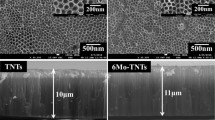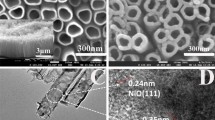Abstract
Titanium dioxide is a promising photocatalyst and has been widely used in many applications. However, it remains challenging to improve the photocatalytic performance of TiO2 under visible light illumination. Herein, a facile one step method was put forward to produce Mn-doped TiO2 nanotube arrays (TNTs) without the formation of manganese oxides. Intermediate band states were generated in Mn-doped TNTs, leading to enhanced visible light absorption and more efficient separation of photo-generated electron–hole pairs. The visible light photocatalysis of Mn-doped TNTs was significantly improved. The method reported here might be extended to the doping of other elements in TNTs and provides opportunities for the design of advanced photocatalysts.
Graphical Abstract
Mn-doped TiO2 nanotubes were developed by a facile method without the formation of separate manganese oxides, which demonstrated significantly improved photocatalytic performance under visible light illumination.






Similar content being viewed by others
References
Zhang S, Xu J, Hu J, Cui C, Liu H (2017) Interfacial growth of TiO2-rGO composite by pickering emulsion for photocatalytic degradation. Langmuir 33(20):5015–5024. https://doi.org/10.1021/acs.langmuir.7b00719
David S, Mahadik MA, Chung HS, Ryu JH, Jang JS (2017) Facile hydrothermally synthesized a novel CdS nanoflower/rutile-TiO2 nanorod heterojunction photoanode used for photoelectrocatalytic hydrogen generation. ACS Sustain Chem Eng 5(9):7537–7548. https://doi.org/10.1021/acssuschemeng.7b00558
Jiang L, Sun L, Yang D, Zhang J, Li Y-J, Zou K, Deng W-Q (2017) Niobium-doped (001)-dominated anatase TiO2 nanosheets as photoelectrode for efficient dye-sensitized solar cells. ACS Appl Mater Interfaces 9(11):9576–9583. https://doi.org/10.1021/acsami.6b14147
Fujiwara K, Kuwahara Y, Sumida Y, Yamashita H (2017) Fabrication of photocatalytic paper using TiO2 nanoparticles confined in hollow silica capsules. Langmuir 33(1):288–295. https://doi.org/10.1021/acs.langmuir.6b04003
Ning X, Wang X, Yu X, Zhao J, Wang M, Li H, Yang Y (2016) Outstanding supercapacitive properties of Mn-doped TiO2 micro/nanostructure porous film prepared by anodization method. Sci Rep 6:22634. https://doi.org/10.1038/srep22634
Song H, Li C, Lou Z, Ye Z, Zhu L (2017) Effective formation of oxygen vacancies in black TiO2 nanostructures with efficient solar-driven water splitting. ACS Sustain Chem Eng 5(10):8982–8987. https://doi.org/10.1021/acssuschemeng.7b01774
Lu Z, Yip CT, Wang L, Huang H, Zhou L (2012) Hydrogenated TiO2 nanotube arrays as high-rate anodes for lithium-ion microbatteries. ChemPlusChem 77(11):991–1000. https://doi.org/10.1002/cplu.201200104
Tan TH, Scott J, Ng YH, Taylor RA, Aguey-Zinsou K-F, Amal R (2016) Understanding plasmon and band gap photoexcitation effects on the thermal-catalytic oxidation of ethanol by TiO2-supported gold. ACS Catal 6(3):1870–1879. https://doi.org/10.1021/acscatal.5b02785
Zhang H, Guo L-H, Wang D, Zhao L, Wan B (2015) Light-induced efficient molecular oxygen activation on a Cu(II)-grafted TiO2/graphene photocatalyst for phenol degradation. ACS Appl Mater Interfaces 7(3):1816–1823. https://doi.org/10.1021/am507483q
Liu Y, Zhou W, Liang Y, Cui W, Wu P (2015) Tailoring band structure of TiO2 to enhance photoelectrochemical activity by codoping S and Mg. J Phys Chem C 119(21):11557–11562. https://doi.org/10.1021/acs.jpcc.5b00623
Suryawanshi MP, Ghorpade UV, Shin SW, Gang MG, Wang X, Park H, Kang SH, Kim JH (2017) Enhanced solar water oxidation performance of TiO2 via band edge engineering: a tale of sulfur doping and earth-abundant CZTS nanoparticles sensitization. ACS Catal 7(12):8077–8089. https://doi.org/10.1021/acscatal.7b02102
Barawi M, De Trizio L, Giannuzzi R, Veramonti G, Manna L, Manca M (2017) Dual band electrochromic devices based on Nb-doped TiO2 nanocrystalline electrodes. ACS Nano 11(4):3576–3584. https://doi.org/10.1021/acsnano.6b06664
Mieritz DG, Renaud A, Seo D-K (2016) Unusual changes in electronic band-edge energies of the nanostructured transparent n-type semiconductor Zr-doped anatase TiO2 (Ti1–xZrxO2; x < 0.3). Inorg Chem 55(13):6574–6585. https://doi.org/10.1021/acs.inorgchem.6b00712
Wang F, Ho JH, Jiang Y, Amal R (2015) Tuning phase composition of TiO2 by Sn4+ doping for efficient photocatalytic hydrogen generation. ACS Appl Mater Interfaces 7(43):23941–23948. https://doi.org/10.1021/acsami.5b06287
Choi H, Shin D, Yeo BC, Song T, Han SS, Park N, Kim S (2016) Simultaneously controllable doping sites and the activity of a W–N codoped TiO2 photocatalyst. ACS Catal 6(5):2745–2753. https://doi.org/10.1021/acscatal.6b00104
Kong J, Rui Z, Ji H (2017) Carbon nitride polymer sensitization and nitrogen doping of SrTiO3/TiO2 nanotube heterostructure toward high visible light photocatalytic performance. Ind Eng Chem Res 56(36):9999–10008. https://doi.org/10.1021/acs.iecr.7b02671
Zheng J, Liu Y, Ji G, Zhang P, Cao X, Wang B, Zhang C, Zhou X, Zhu Y, Shi D (2015) Hydrogenated oxygen-deficient blue anatase as anode for high-performance lithium batteries. ACS Appl Mater Interfaces 7(42):23431–23438. https://doi.org/10.1021/acsami.5b07000
Sarkar D, Ishchuk S, Taffa DH, Kaynan N, Berke BA, Bendikov T, Yerushalmi R (2016) Oxygen-deficient titania with adjustable band positions and defects; molecular layer deposition of hybrid organic–inorganic thin films as precursors for enhanced photocatalysis. J Phys Chem C 120(7):3853–3862. https://doi.org/10.1021/acs.jpcc.5b11795
Ho Y-C, Hoque MNF, Stoneham E, Warzywoda J, Dallas T, Fan Z (2017) Reduction of oxygen vacancy related traps in TiO2 and the impacts on hybrid perovskite solar cells. J Phys Chem C 121(43):23939–23946. https://doi.org/10.1021/acs.jpcc.7b08384
Khan H, Swati IK (2016) Fe3+-doped anatase TiO2 with d–d transition, oxygen vacancies and Ti3+ centers: synthesis, characterization, UV–vis photocatalytic and mechanistic studies. Ind Eng Chem Res 55(23):6619–6633. https://doi.org/10.1021/acs.iecr.6b01104
Murashkina AA, Murzin PD, Rudakova AV, Ryabchuk VK, Emeline AV, Bahnemann DW (2015) Influence of the dopant concentration on the photocatalytic activity: Al-doped TiO2. J Phys Chem C 119(44):24695–24703. https://doi.org/10.1021/acs.jpcc.5b06252
Rossi G, Calizzi M, Di Cintio V, Magkos S, Amidani L, Pasquini L, Boscherini F (2016) Local structure of V dopants in TiO2 nanoparticles: X-ray absorption spectroscopy, including ab-initio and full potential simulations. J Phys Chem C 120(14):7457–7466. https://doi.org/10.1021/acs.jpcc.5b12045
Cao C, Yan Y, Yu Y, Yang X, Liu W, Cao Y (2017) Modification of Pd and Mn on the surface of TiO2 with enhanced photocatalytic activity for photoreduction of CO2 into CH4. J Phys Chem C 121(1):270–277. https://doi.org/10.1021/acs.jpcc.6b08921
Zhang J, Li L, Xiao Z, Liu D, Wang S, Zhang J, Hao Y, Zhang W (2016) Hollow sphere TiO2–ZrO2 prepared by self-assembly with polystyrene colloidal template for both photocatalytic degradation and H2 evolution from water splitting. ACS Sustain Chem Eng 4(4):2037–2046. https://doi.org/10.1021/acssuschemeng.5b01359
Lavric V, Isopescu R, Maurino V, Pellegrino F, Pellutiè L, Ortel E, Hodoroaba V-D (2017) A new model for nano-TiO2 crystal birth and growth in hydrothermal treatment using an oriented attachment approach. Cryst Growth Des 17(11):5640–5651. https://doi.org/10.1021/acs.cgd.7b00302
Challagulla S, Nagarjuna R, Ganesan R, Roy S (2016) Acrylate-based polymerizable sol–gel synthesis of magnetically recoverable TiO2 supported Fe3O4 for Cr(VI) photoreduction in aerobic atmosphere. ACS Sustain Chem Eng 4(3):974–982. https://doi.org/10.1021/acssuschemeng.5b01055
Xiong Y, He D, Jaber R, Cameron PJ, Edler KJ (2017) Sulfur-doped cubic mesostructured titania films for use as a solar photocatalyst. J Phys Chem C 121(18):9929–9937. https://doi.org/10.1021/acs.jpcc.7b01615
Krbal M, Sopha H, Podzemna V, Das S, Prikryl J, Macak JM (2017) TiO2 nanotube/chalcogenide-based photoelectrochemical cell: nanotube diameter dependence study. J Phys Chem C 121(11):6065–6071. https://doi.org/10.1021/acs.jpcc.6b11283
Cho IS, Choi J, Zhang K, Kim SJ, Jeong MJ, Cai L, Park T, Zheng X, Park JH (2015) Highly efficient solar water splitting from transferred TiO2 nanotube arrays. Nano Lett 15(9):5709–5715. https://doi.org/10.1021/acs.nanolett.5b01406
Liu N, Paramasivam I, Yang M, Schmuki P (2012) Some critical factors for photocatalysis on self-organized TiO2 nanotubes. J Solid State Electrochem 16(11):3499–3504. https://doi.org/10.1007/s10008-012-1799-z
Sharma S, Chaudhary S, Kashyap SC, Sharma SK (2011) Room temperature ferromagnetism in Mn doped TiO2 thin films: electronic structure and Raman investigations. J Appl Phys 109(8):951. https://doi.org/10.1063/1.3567938
Cai Z, Zhao X, Wang T, Liu W, Zhao D (2016) A Reusable platinum-deposited anatase/hexa-titanate nanotubes: roles of reduced and oxidized platinum on enhanced solar-light-driven photocatalytic activity. ACS Sustain Chem Eng 5(1):547–555. https://doi.org/10.1021/acssuschemeng.6b01931
Liu W, Cai Z, Zhao X, Wang T, Li F, Zhao D (2016) High-capacity and photoregenerable composite material for efficient adsorption and degradation of phenanthrene in water. Environ Sci Technol 50(20):11174–11183. https://doi.org/10.1021/acs.est.6b02623
Wang Z-S, Huang C-H, Huang Y-Y, Hou Y-J, Xie P-H, Zhang B-W, Cheng H-M (2001) A highly efficient solar cell made from a dye-modified ZnO-covered TiO2 nanoporous electrode. Chem Mater 13:678–682. https://doi.org/10.1021/cm000230c
Mor GK, Shankar K, Paulose M, Varghese OK, Grimes CA (2006) Use of highly-ordered TiO2 nanotube arrays in dye-sensitized solar cells. Nano Lett 6:215–218. https://doi.org/10.1021/nl052099j
Zaban A, Greenshtein M, Bisquert J (2003) Determination of the electron lifetime in nanocrystalline dye solar cells by open-circuit voltage decay measurements. ChemPhysChem 4(8):859–864. https://doi.org/10.1002/cphc.200200615
Li XZ, Li FB (2002) Surface characterization and photocatalytic reactivity of innovative Ti/TiO2 and Ti/Pt-TiO2 mesh photoelectrodes. J Appl Electrochem 32(2):203–210. https://doi.org/10.1023/A:1014761814254
Gracien EB, Shen J, Sun XR, Liu D, Li M, Yao SD, Sun J (2007) Photocatalytic activity of manganese, chromium and cobalt-doped anatase titanium dioxide nanoporous electrodes produced by re-anodization method. Thin Solid Films 515(13):5287–5297. https://doi.org/10.1016/j.tsf.2006.12.187
Tsutomu Hirakawa† A, ‡ PVK (2005) Charge separation and catalytic activity of Ag@TiO2 core–shell composite clusters under UV–irradiation. J Am Chem Soc 127(11):3928. https://doi.org/10.1021/ja042925a
Yang M, Cheng H, Gu Y, Sun Z, Hu J, Cao L, Lv F, Li M, Wang W, Wang Z, Wu S, Liu H, Lu Z (2015) Facile electrodeposition of 3D concentration-gradient Ni-Co hydroxide nanostructures on nickel foam as high performance electrodes for asymmetric supercapacitors. Nano Res 8(8):2744–2754. https://doi.org/10.1007/s12274-015-0781-3
Acknowledgements
This work was supported by National Natural Science Foundation of China (Grants No. 61604058), and Guangdong Science and Technology Department (Grant No. 2015A020215011).
Author information
Authors and Affiliations
Corresponding author
Rights and permissions
About this article
Cite this article
Xu, Z., Li, C., Fu, N. et al. Facile synthesis of Mn-doped TiO2 nanotubes with enhanced visible light photocatalytic activity. J Appl Electrochem 48, 1197–1203 (2018). https://doi.org/10.1007/s10800-018-1198-y
Received:
Accepted:
Published:
Issue Date:
DOI: https://doi.org/10.1007/s10800-018-1198-y




